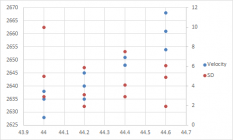Below are the results of some of my testing: Weight vs Average Speed and ES. This was done with 5 shot groups.
I suppose you could say there's a flattening of the velocity between 43.5 and 44. Or that 43.5 had a higher average velocity than the general trend. Either way, I don't see it as statistically significant enough nor have a significant enough correlation with group size, shape or centre location to investigate further.

I use ES and the groups shot at each weight to chose my load.
I suppose you could say there's a flattening of the velocity between 43.5 and 44. Or that 43.5 had a higher average velocity than the general trend. Either way, I don't see it as statistically significant enough nor have a significant enough correlation with group size, shape or centre location to investigate further.

I use ES and the groups shot at each weight to chose my load.













